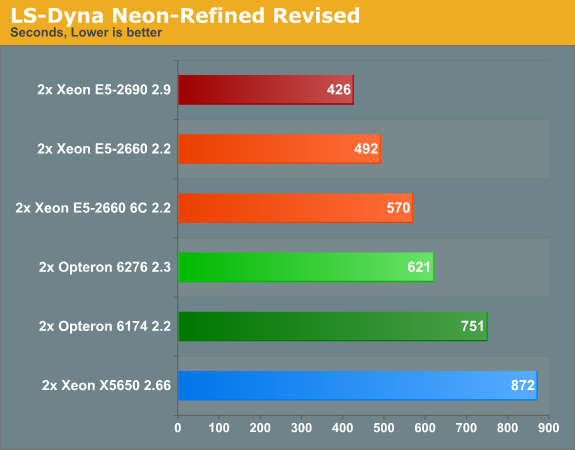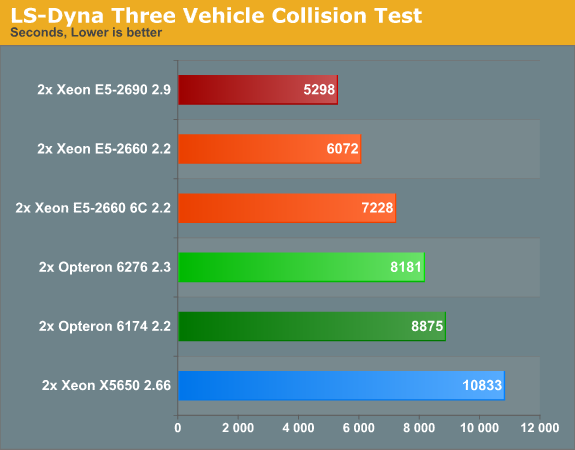The Xeon E5-2600: Dual Sandy Bridge for Servers
by Johan De Gelas on March 6, 2012 9:27 AM EST- Posted in
- IT Computing
- Virtualization
- Xeon
- Opteron
- Cloud Computing
LS-DYNA
LS-DYNA is a "general purpose structural and fluid analysis simulation software package capable of simulating complex real world problems", developed by the Livermore Software Technology Corporation (LSTC). It is used by the automobile, aerospace, construction, military, manufacturing and bioengineering industry. Even simple simulations take hours to complete, so even a small performance increase results in tangible savings. Add to that that many of our readers have been asking that we perform some benchmarking with HPC workloads. So reasons enough to include our own LS-DYNA benchmarking.
These numbers are not directly comparable with AMD's and Intel's benchmarks as we did not perform any special tuning besides using the message passing interface (MPI) version of LS-DYNA ( ls971_mpp_hpmpi ) to run the LS-DYNA solver to get maximum scalability. This is HP-MPI version of LS-DYNA 9.71.
Our first test is a refined revised Neon crash test simulation.

This is one of the few benchmarks (besides SAP) where the Opteron 6276 outperforms the older Opteron 6174 by a tangible margin (about 20% faster) and is significantly faster than the Xeon 5600, by 40% to be more precise. However, the direct competitor of the 6276, the Xeon E5-2630, will do a bit better (see the E5-2660 6C score). When you are aiming for the best performance, it is impossible to beat the best Xeons: the Xeon E5-2660 offers 26% better performance, the 2690 is 46% faster. It is interesting to note that LS-Dyna does not scale well with clockspeed: the 32% higher clockspeed of the Xeon E5-2690 results in only a 15% speed increase.
A few other interesting things to note: we saw only a very smal performance increase (+5%) due to Hyperthreading. Memory bandwidth does not seem to be critical either, as performance increased by only 6% when we replaced DDR3-1333 with DDR3-1600. If LS-Dyna was bottlenecked severely by the memory speed we should have seen a performance increase close to 20% (1600 vs 1333).
CMT boosted the Opteron 6276's performance by up to 33%, which seems weird at first since LS-DYNA is a typical floating point intensive application. As the shared floating point "outsources" load and stores to the integer cores, the most logical explanation is that LS-DYNA is limited by the load/store bandwidth. This is in sharp contrast with for example 3DS Max where the additional overhead of 16 extra threads slowed the shared FP down instead of speeding it up.
Also, both CPUs seem to have made good use of their turbo capabilities. The AMD Opteron was running at 2.6 GHz most of the time, the Xeon 2690 at 3.3 GHz and the Xeon 2660 at 2.6 GHz.
The second test is the "Three Vehicle Collision Test" simulation, which runs a lot longer.

The three vehicle collision test does not change the benchmarking picture, it confirms our early findings. The Opteron Interlagos does well, but the Xeon E5 is the new HPC champion.










81 Comments
View All Comments
silverblue - Thursday, March 8, 2012 - link
You've put that Interlagos has 4x2MB L2, but that would only be true for Valencia; Interlagos is 8x2MB.aranyagag - Thursday, March 8, 2012 - link
you forgot the E5-2687W with a 150w tdp and higher speedscolonelclaw - Friday, March 9, 2012 - link
Hi There,Thanks for an excellent article. With regards to the rendering benchmarks, would you consider using VRay as a rendering engine? It's fast becoming industry standard, is compatible with all the big hitters (Max, Maya, Softimage etc), is cross platform, and I believe, is incredibly well coded to scale with cores.
It's also incredibly popular, not something you could say about iRay right now.
Slik - Saturday, March 10, 2012 - link
Would be nice if some game benchmark was included as well.colonelclaw - Wednesday, March 14, 2012 - link
Bloody hell those chips look good, and don't Intel know it; those prices make me wince.Having waited what seems like forever, I was thrilled to see the Xeon E5s finally available, right up until I did some quick maths and figured out that for my business to buy a new 2U Twin squared rendernode with 16/32 cores per node will cost us around £10,000. Still the thing is, now that those chips are available, next time we buy kit we can't afford not to choose them.
Skouperd - Tuesday, March 20, 2012 - link
Great article... but can it run crysis?Seriously, what will happen if you plug in some high end graphics card in that machine, how will that compare from a gaming perspeective to say an LGA2011 cpu?
;-)
fudd101 - Wednesday, April 4, 2012 - link
From the 'article' .....'The Opteron might also have a role in the low end, price sensitive HPC market, where it still performs very well. It won't have much of chance in the high end clustered one as Intel has the faster and more power efficient PCIe interface'
Well, if that's the case, why exactly would AMD be scoring so many design wins with Interlagos. Including this one ...
http://www.pcmag.com/article2/0,2817,2394515,00.as...
http://www.eweek.com/c/a/IT-Infrastructure/Cray-Ti...
U think those guys at Cray were going for low performance ? In fact, seems like AMD has being rather cleaning up in the HPC market since the arrival of Interlagos. And the markets have picked up on it, AMD stock is thru the roof since the start of the year. Or just see how many Intel processors occupy the the top 10 supercomputers on the planet. Nuff said ...
jaskhoo - Wednesday, July 11, 2012 - link
Hi, abit blur here and would like to know if there's anyone who could enlighten abit.I'm looking to purchase a new server to work with an SQL 2012 4 core, the initial ppreference was for an E5620 which is now an outdated model but I can't go for higher E5-xxx models as all are 6 core and will affect the 4 core SQL licensing. I'm not running a huge databse but would like to know if there are any serious performance difference between the two processor. Appreciate it.
famalosa - Tuesday, April 26, 2016 - link
Les deux platines ci-dessus commençons par lance Gobelins ou la bombe tour/Canon au début de la bataille lorsque la barre de l'élixir obtient autour de 10. Je vais tout d'abord si l'ennemi a au compteur et ils ont habitude de laisser tomber tout d'abord une grosse carte ou utilisez les flèches. Puis jouer à votre avantage avec le coût de l'élixir, troupes pour la défense et une attaque forte. Déposer le Canon ou la tour au milieu de rerouter les agresseurs et pour la défense.<a href="http://clashroyalhack.fr/">CR hack</a>
famalosa - Tuesday, April 26, 2016 - link
Le pont sur la gauche est une mise en page « plus grand risque de mieux récompenser », tandis que celui de droite est un jeu plus lent que prendra de temps et patience pour gagner. Tous deux sont extrêmement compétents et me laisser pousser à Arena 7.http://clashroyalhack.fr/